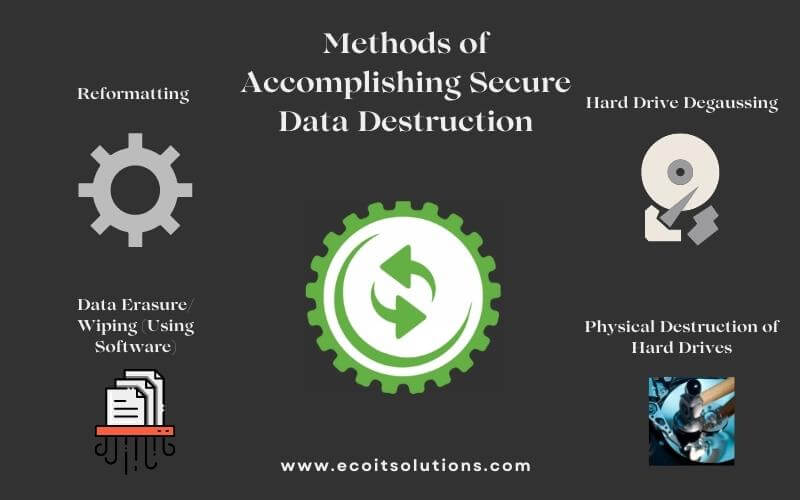How to Integrate Data Destruction Techniques right into Your Cyber Security Technique
Wiki Article
Checking Out the Significance of Data Destruction in the Context of Computer Security Solutions and Protecting Confidential Data
In a period where data violations are increasingly usual, the relevance of effective data damage can not be overstated. What techniques can organizations execute to boost their information destruction procedures?Comprehending Data Damage
Data devastation is a critical element of computer protection that involves the permanent removal of data from storage space gadgets to avoid unapproved gain access to and potential data breaches. In an increasingly electronic landscape, organizations deal with enhanced dangers connected with delicate information being poorly accessed or made use of. Reliable data damage safeguards against these threats, guaranteeing that private dataâEUR" such as client details, intellectual building, and economic recordsâEUR" can not be recuperated after disposal.Understanding the value of information damage prolongs beyond simple compliance with lawful and regulatory frameworks; it is vital for maintaining organizational integrity and count on. When data is poorly managed or inadequately ruined, the effects can be severe, consisting of economic loss, reputational damages, and legal obligations.

Approaches of Information Obliteration

One widespread method is information wiping, which includes overwriting existing information with random patterns numerous times. This method renders the original information irretrievable, making it a popular option for organizations seeking to safeguard private info.
An additional method is degaussing, which utilizes an effective magnetic area to interrupt the magnetic domains on storage space devices, effectively removing the information. This strategy is specifically efficient for magnetic media however is not suitable to solid-state drives.
Physical devastation is one more robust method, crushing or involving the shredding of storage space gadgets. This approach assurances that information healing is virtually difficult, making it perfect for extremely delicate information.
Lastly, file encryption can work as a complementary method to information eradication. By securing data prior to removal, companies can add an additional layer of protection, making certain that also if residues are recouped, they stay hard to reach without the decryption trick. Each method should be selected based on the degree of data sensitivity and the details safety and security requirements of the company.
Legal Conformity and Data Safety And Security
Organizations have to navigate a complicated landscape of lawful requirements associated with data safety and security, particularly after executing techniques of information elimination. Numerous guidelines, such as the General Information Defense Regulation (GDPR) and the Medical Insurance Transportability and Liability Act (HIPAA), enforce rigorous standards on how organizations have to handle and get rid of of sensitive information. Failure to conform with these guidelines can result in significant legal consequences, consisting of considerable penalties and reputational damage.Information damage procedures need to be thoroughly recorded to show compliance with applicable legislations and requirements. This documents not only serves as evidence of adherence to legal commitments yet also illustrates a dedication to protecting sensitive information. Organizations should likewise establish clear policies relating to data retention and devastation timelines, making certain that information is not held longer than necessary.

Additionally, regular audits and evaluations of data devastation practices are vital to preserve conformity and adapt to advancing legal frameworks (data destruction). By proactively resolving lawful demands, companies can minimize dangers connected with data breaches and show their dedication to data safety and security. Inevitably, prioritizing lawful compliance in data damage procedures is not simply a regulative responsibility, however a fundamental aspect of a robust data safety and security strategy
Impact on Company Reputation
The reputation of a business can be dramatically influenced by its method to information destruction and management. In today's electronic landscape, where data breaches can take place anytime, the failure to correctly throw away sensitive info can bring about extreme effects. Organizations that improperly handle information devastation danger revealing private customer information, which not just breaks privacy regulations however also deteriorates depend on amongst Visit Your URL customers and stakeholders.A tarnished track record can cause decreased customer commitment, as customers end up being reluctant to engage with a company that has actually demonstrated neglect in securing their information. Unfavorable promotion surrounding an information breach can have an enduring result, as potential customers could be discouraged by the viewed lack of protection. This can bring about a direct decrease in profits and market share.
Furthermore, organizations that focus on information devastation as part of their security approach can improve their track record by showcasing their dedication to protecting delicate information. By adopting stringent data monitoring methods, organizations can not just mitigate risks however additionally place themselves as trustworthy entities in their respective markets, consequently strengthening their general brand name image.

Best Practices for Secure Disposal
Executing best methods for protected disposal of data is crucial for minimizing dangers related to information violations and guaranteeing compliance with privacy policies. Organizations ought to adopt a comprehensive data disposal policy that details procedures for both physical and digital data damage.For physical information storage devices, such as hard disk drives, shredding or degaussing is recommended to stop information recovery. In addition, companies ought to keep a chain of custody paperwork throughout the disposal process, ensuring responsibility and traceability of disposed items.
For electronic information, utilizing software application that follows sector standards for information cleaning is essential. This software should overwrite existing information multiple times, making healing essentially impossible. It is also essential to confirm the performance of the information devastation process through audits or third-party analyses.
Training employees on safe and secure disposal techniques adds an additional layer of safety, as human mistake can frequently bring about information direct exposure. Frequently upgrading and assessing disposal plans guarantees alignment with evolving regulations and technological advancements. By carrying out these finest methods, companies can dramatically reduce the risk of unauthorized data access and boost their total information protection technique.
Verdict
Finally, information destruction is a basic element navigate here of computer system safety and security solutions that guarantees the protection of personal details from unapproved access. Executing reliable methods of information obliteration, sticking to lawful conformity, and recognizing the effect on company credibility are essential components of a article detailed information safety and security technique. By embracing ideal practices for safe disposal, companies can cultivate trust with customers and secure delicate information, eventually adding to an extra safe digital landscape.In a period where data breaches are increasingly usual, the relevance of effective data destruction can not be overemphasized.Data damage is a vital element of computer safety and security that involves the long-term removal of information from storage tools to avoid unapproved gain access to and potential data violations. Organizations ought to likewise establish clear policies pertaining to information retention and damage timelines, guaranteeing that data is not held longer than essential.
By proactively resolving lawful needs, organizations can alleviate risks associated with information breaches and demonstrate their commitment to data security (data destruction). Inevitably, focusing on legal compliance in data destruction processes is not simply a regulatory obligation, yet an essential facet of a robust data safety technique
Report this wiki page